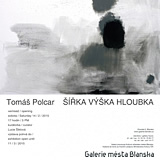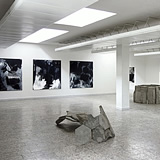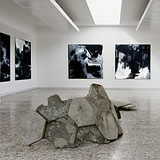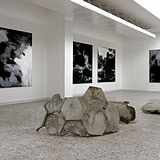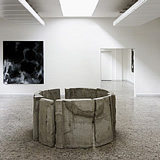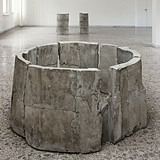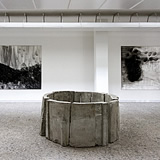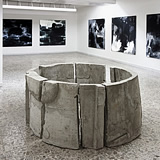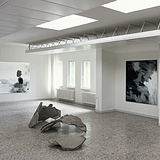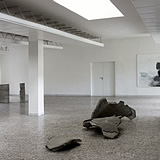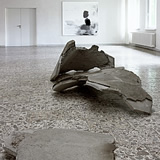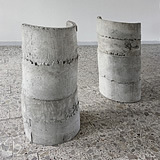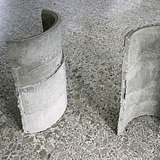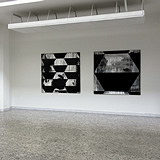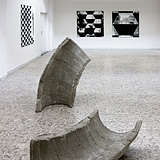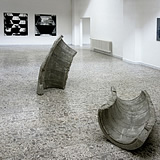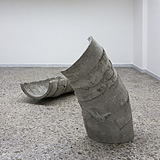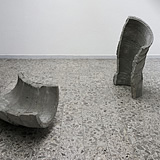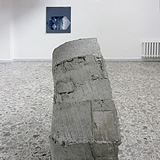WIDTH, HEIGHT, DEPTH
City Gallery Blansko
15. 2. – 11. 3. 2015
Every concept is predestined to its own death if one tries to accomplish it without spirit.
Tomáš Polcar belongs to that generation of artists who made a distinctive impression during their emergence in the 1990s. It is a specific generation, one that still experienced the gray and oppressive pre-1989 era but that matured and fully came into its own in free artistic times. The Academy of Fine Arts caught a fresh wind and reformed itself as well, attracting inspirational professors and organizing joint exhibitions. This constellation naturally shaped the school’s young and emerging artists, and over time has proven to be an excellent mold that has yielded several unique artistic personalities. Tomáš Polcar attended three very distinctive studios at the academy, where he was shaped by three artistic legends: Hugo Demartini, Aleš Veselý, and Milan Knížák. From Demartini, he learned a sense for material and form; from Veselý a fascination with content, energy, and proportions; from Knížák a focus on reflection, communication, and ideas.
In the 1990s, Polcar participated in every important event and exhibition of his generation, including the Second Biennial of Young Artists (City Gallery Prague, Stone Bell House, 1996); Reduced Budget (Mánes, 1998); CZ 99 (Wenceslaus Square, 1999); The End of the World, National Gallery (2000). In addition to traditional art, he also spent some time captivated by new media, and his interventions Advertising Campaign for Ordinary Objects and Portraits of Naked People in 1998 (both held in tandem with Ester Polcarová) are impossible to overlook.
Campaign was in fact more of an anti-campaign, for which the artists selected five of the most ordinary items – a chair, bread, a shoe, skis, and a potato – which they photographed in the most ordinary way possible in order to let the depicted objects speak only for themselves. They displayed them on billboards, illuminated advertising kiosks, and posters in Prague’s metro and streetcars. In and of themselves, a large potato on a billboard on the Barrandov highway bridge or along the city’s main arterial near the National Museum felt like viruses in an advertising campaign. In Portraits, Polcar placed seven photographic portraits in the transfer corridors of Prague’s “Muzeum” station – except that the “naked” people were only shown from the head up. Nakedness and intimacy were reflected exclusively in their faces. The project’s aim was to juxtapose the alienated industrial space and anonymous masses with the personal intimacy that Polcar experienced on his daily travels by metro. Both anonymous interventions in the city’s subway system were seen by many people, but nobody knew who was behind them. What was important was the message, the act of pulling people out of their lethargy and bringing ideas to life. The point was not to draw attention to oneself. This characteristic becomes even more distinct after the Polcars leave Prague for Slavětín on the Ohře River.
Tomáš Polcar is a seeker by nature. He is not interested in a navel-gazing exploration of his own being, but his search inevitably touches on his “I” – with an emphasis more on the Jungian self instead of the Freudian ego. At the start of each searching expedition, culminating in a self-contained cycle, lies an encounter with the expression of form as a reified principle. These encounters cause a thought process to unfold that Polcar retroactively makes visible and encloses in matter and new form as paintings and sculptures.
Polcar’s canvas paintings and classical three-dimensional objects are capable of standing on their own and can be seen as distinctive works of art per partes. Despite his undisguised attraction to tradition and his clearly classical approach, he is a conceptualist. Thus his relationship to form, in which he does not make himself at home but which he alternates according to feeling and need.
Some artists reject the idea of a signature style on principle. In a kind of inverse way, not having a signature style or manner can, à la Dokoupil, become a formalist feature and indirect signature in its own right. Within this context, Polcar’s manner is ideas.
Lucie Šiklová, curator, 2015
Photo: Ester Polcarová
